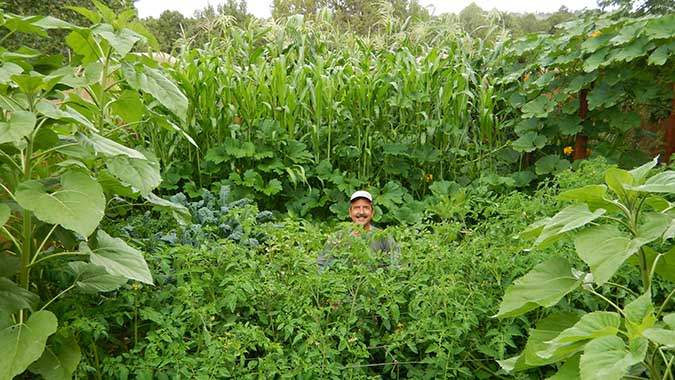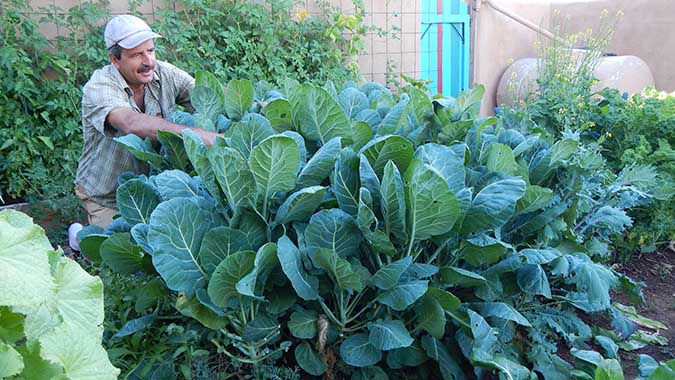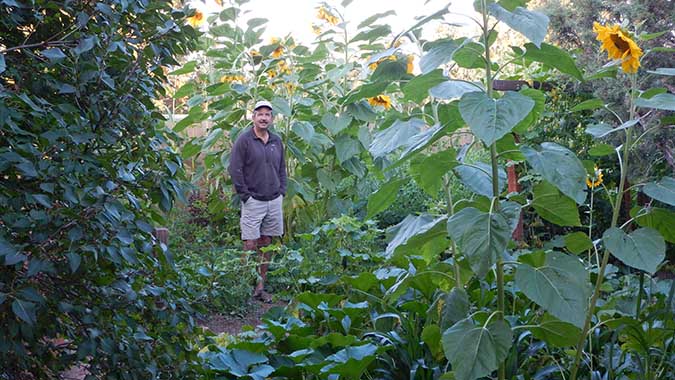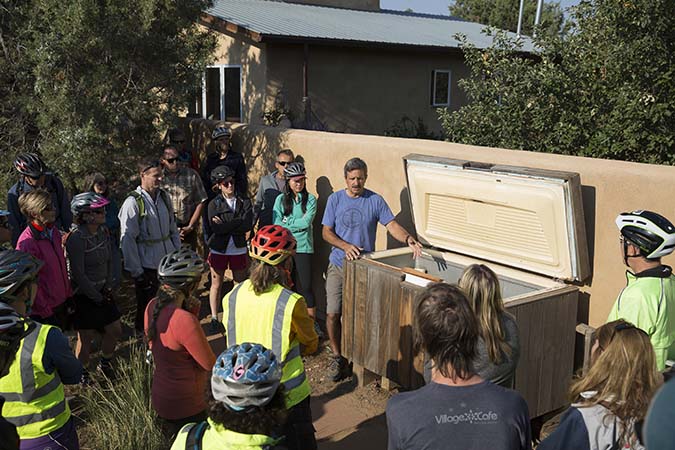TGN Interviews Tom Bartels About Bio-intensive Gardening, the Soil Foodweb, and How to Let Organic Compost Do the Work for You
Home digs: Durango, CO
Organization: GrowFoodWell.com
Fast facts: Call him an organic gardener, horticulture coach, or fanatical home-grown food fan—just call him. Because Tom Bartels wants to help us all be part of the solution in creating a healthier ecosystem. The former commercial video producer turned bio-intensive gardening guide today touts organic solutions to growing “astounding” amounts of food at home. He’s done so himself for nearly 20 years in the high desert of southwest Colorado—with an annual backyard yield of 1,000+ pounds in 1,300 square feet. (His frost-free growing season only totals 130 days, by the way!) He even used the same techniques to create a 4,000-square-foot demonstration garden in downtown Durango to prove how quickly a typical lawn can be turned into an organic market garden. It all speaks to Tom’s spirit of self-reliance, soil repair, and realignment with the Earth’s natural environmental order through local, nutrient-rich food production. We’ll eat to that!
___________________________________________
Can you recount a turning point that saw the genesis of GrowFoodWell.com take shape in your mind?
I was growing about 1,000 pounds of organic food in my yard each summer—in a 130-day growing season. I realized it wasn’t really that hard, once you understand how natural systems work. So, I decided to create the video curriculum for all my workshops, and off I went.
You teach and advocate tirelessly on nourishing the “Soil Foodweb.” Can you start by giving us a lesson in basic soil biology?
That’s a world unto itself, and there are tons of great books on it, but I’ll give you an accelerated version here. Once you understand how the microorganisms in the Soil Foodweb help your plants thrive, it will change the way you grow food. The phrase Soil Foodweb was coined by Dr. Elaine Ingham, who’s a soil biology researcher. Basically, it refers to the uncountable numbers of microorganisms in healthy garden soil. Bacteria, microarthropods, protozoa, nematodes—there are over a billion organisms in a teaspoon of good garden soil, and over 10,000 different species in that same sample. They work in a symbiotic relationship with plants that goes back millions of years. The plants release exudates from the tips of the roots, which feed the organisms, who then surround and protect the plant from pathogens as they excrete waste products the plant uses for food. You simply make sure those little organisms are eagerly feeding off compost in the meantime, and all your plants get happy.
Read More:
“5 Cheap and Easy Solutions for Small-Space Composting”
“Supercharge Your Garden! 4 Steps to Vibrant Soil Using Compost and Crop Rotation”
“Continuous Composting: Get Great Compost Without the Work!“
What are the down-and-dirty starter steps involved in creating a healthy soil environment in a backyard or midsize bio-intensive garden? What specific resources do you recommend?
Starting out, you want a sunny spot, with at least six hours of sun per day during the growing season. Soil depths over 18 inches are necessary for this kind of growing. All my beds are at least 2 feet deep.
Double-digging is optional at first, but many people need it since their soil profile is compressed and has little organic matter. You’re eventually shooting for around 10 percent organic matter in your soil, and an active Soil Foodweb. Once you get there, you can start transitioning to no-till methods, and life gets that much easier. So, if you are just starting out, beds should be less than 4 feet across and however long you like—20 feet, 50 feet, or whatever size you will actually have time for during the season. I’ve been running 1,500 square feet of veggies most years, and once things are planted, I can turn on the drip system and simply manage from there.
So, I do advocate drip irrigation on a timer, since we all have busy lives and forget to water the garden that is relying on us to do so. (When this happens, plants go into stress and then a negative spiral with weeds and pests.) That’s one of the reasons people get turned off to gardening, since they think it takes so much time. But if you set things up to mimic a forest ecosystem, it turns out that it can be fairly easy. I sometimes leave for a month at a time during the growing season, and the garden does just fine. My curriculum walks people through designing the garden in such a way that they no longer feel chained to it all season. Once they implement the bio-intensive methods, most students can double their yields and cut their work in half.
Organic compost is key to your program. Can you detail how you employ it to, as you say, do the work for you for much of the year?
I use four traditional compost bins to process most of the organic matter that’s left over in the gardens each year. I use a fair amount of leaves in those bins as well. I have taken to adding compost worms to that system, which reduces my labor quite a bit. They have enough insulation in the piles to keep working through the winter, so I don’t have to turn the piles as much, and I get the added benefit of enzymes from the worms that help create aggregate soil that holds more water, which is key in the drought-prone Southwest. I also use a recycled 1974 GE top-loading freezer that I made into a year-round worm bin. That receives all the small batches of kitchen waste that we produce every few days. That cycling is just about right for the worms and gives them enough to process through the winter as well. Then, the most recent addition to the compost systems has been giant piles of leaves that are delivered in the autumn from landscapers who would otherwise be paying to send them to the dump. Keep your leaves, people. They are a great carbon resource for gardens. I layer the piles 10 inches at a time, and soak with water as I go (finished piles are around 12 feet in diameter and 6 feet in height). They have so much mass that they stay well above 100°F for a year or more, even during Colorado winters. I add about 4,000 worms to a pile to start it off. Within about a year and a half or two years, they multiply to many times that number and break the entire pile down into roughly 50 wheelbarrow loads of worm castings. I use it as “reserve fertility.” It’s a great way to be creating soil amendment while not doing any work.
How crucial a role do worms play in helping to “regenerate” the soil?
Well, as I mentioned above, they provide some pretty incredible services. When you keep these systems going year-round, the populations of worms in the different piles keep multiplying (they eat their body weight each day and double their numbers every three months). When added to garden soil, they help perforate the entire soil profile, bringing water, castings, and oxygen deeper into your beds. Worm compost tea is also great for supporting plant health.
Can you offer a tried-and-true plan for designing irrigation systems that promote self-sufficiency—from rainwater collection to drip systems and beyond?
Well, it’s hard to do a dedicated rainwater collection for an entire season, unless you’re somewhere that has lots of rain! Since we only get about 20 inches of precipitation each year, we definitely need some automated drip systems to keep everything alive. I do have three rain tanks that collect rain during the downpours, and I use them to water trees mostly. A simple drip system can save you tons of time. Put in a $30 timer, and your summer is so much easier. DripWorks has some ready-made designs that you can see on their website in the design section. If you’re good with your hands, you can fashion your own drip lines, but there are many good companies making them in rolled lengths. Drip irrigation saves a load of water and only places it on the root zone, where the plant can use it most efficiently. It also reduces waterborne disease since it minimizes splash on leaves. It does take a bit of time each season to set up, but is done in a weekend—and when you add up all the hours it would have taken to hand water for the whole season, it becomes obvious that it’s a great time-saver. Make sure you take care of the drip lines in the off season, and they can last a surprising number of years.
You argue for using soil blocks as an efficient seed-starter system. Why, and what are the basic tenets of the practice?
Many new gardeners have had that experience of starting seedlings in plastic cell trays, then babying them along under lights or on window sills, etc. Then the day comes to transplant them into the beds, and they get bumped and pinched enough that they get root shock or have any number of stress responses. Soil blocks reduce root shock since you never have to handle the roots. You simply place the 2-inch soil block in a hole and cover it up. This process just provides a higher success rate during transplant. It also sidesteps using all the plastic in those cell trays, since the blocks stand on their own. You do need square water trays below them, but you can re-use them for seven or eight years. [See Tom’s step-by-step soil block instructions, including soil mix ingredients.]
To till or not to till? Please share the wisdom behind your principles and practices.
Tilling soil breaks it down, period. Civilizations throughout history have overworked their soil with disastrous results. But in startup garden situations, it may be necessary to get things going by doing a controlled double-dig with a garden fork and spade. Then, over time, you should be working your soil less and less—adding compost until you get to no-till or low-till situations.
I started all my beds (heavy clay soil) by doing a standard double-dig, through which you introduce air and carbon material into the lower foot of soil and then carefully replace the upper foot of soil back on top, since it contains most of the living organisms. By starting a bed this way and amending that lower soil, it allows vegetable plants to more easily send roots down to that second foot, increasing their access to food and water. Once that condition is created, the plants don’t try to grow lateral roots to compete with neighboring plants, so you can plant at intensive spacings and gain all the benefits of a closed canopy on the bed. As you amend the beds each year with organic compost, the Soil Foodweb and worms will keep improving the soil profile, until eventually all you may need in the spring is some aeration with a broadfork, and ultimately no till. All 17 of my beds are no till now and are producing as much, or more, than they ever have. I couldn’t have started out that way, though, with my soil base.
Any last tidbit of gardening, eating, or healthy living advice that would be of interest to our Grow Network community?
Growing organic food at home is one of the best ways to reconnect with your health, your family, your neighbors, and the biosphere in general. It reconnects people to the planet. It reminds us how to be a dynamic, cooperative participant in the natural systems that surround and support us. Things are getting kind of wonky out there with climate wobbling, etc., and the industrial food system is creating “food-like products” with questionable nutrition. Regenerative agricultural methods on a wider scale hold some key solutions to the various natural systems out there that need support. And on the personal scale, eating more local, organic food—some of which you can grow yourself—is one of those really clear decisions that just makes sense. You don’t have to grow your entire diet, but start small, and see how far you get. Once you get the hang of it, and your yields keep increasing (as your soil keeps getting healthier), you’ll wonder why you didn’t start 10 years earlier. Many of my students have been amazed at what they could grow in their own yards. They get so many benefits from the varied experiences of having their hands in the soil, and food right outside their door, that it becomes one of their favorite parts of life.
So, get out there and grow some food!
___________________________________________
The Grow Network is a participant in the Amazon Services LLC Associates Program, an affiliate program designed to provide a means for our team to earn fees for recommending our favorite products! We may earn a small commission, at no additional cost to you, should you purchase an item after clicking one of our links. Thanks for supporting TGN!

The Grow Network is a global network of people who produce their own food and medicine. We’re the coolest bunch of backyard researchers on Earth! We’re constantly sharing, discovering, and working together to test new paths for sustainable living—while reconnecting with the “old ways” that are slipping away in our modern world. We value soil, water, sunlight, simplicity, sustainability, usefulness, and freedom. We strive to produce, prepare, and preserve our own food and medicine, and we hope you do, too!












COMMENTS(2)
Love this!!! Very inspirational!
I would be happy with a quarter of his yield!